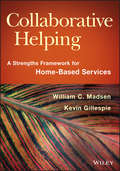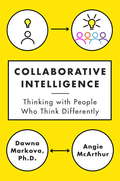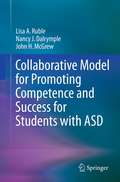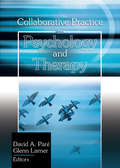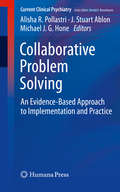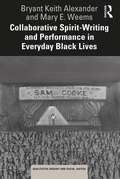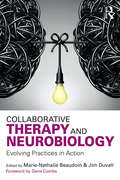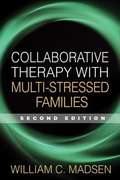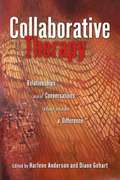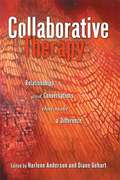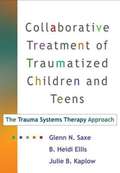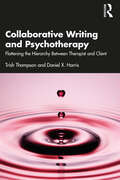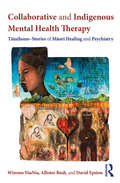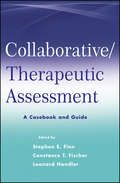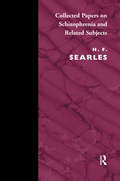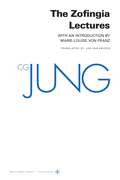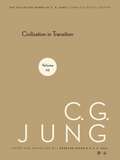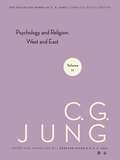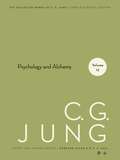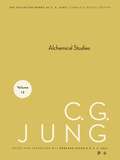- Table View
- List View
Collaborative Helping: A Strengths Framework for Home-Based Services
by William C. Madsen Kevin GillespieAn interdisciplinary framework for sustainable helping through cross-system collaborationThis hands-on resource provides clear, practical guidance for supportive service professionals working in a home-based environment. Drawing on best practices from a range of disciplines, this book provides a clear map for dealing with the complex and often ambiguous situations that arise with individuals and families, with applications extending to supervision and organizational change. Readers gain the advice and insight of real-world frontline helpers, as well as those who receive care, highlighting new ways to approach the work and re-think previous conceptualizations of problems and strengths. Helping efforts are organized around a shared, forward-thinking vision that anticipates obstacles and draws on existing and potential supports in developing a collaborative plan of action.The book begins with stories that illustrate core concepts and context, presenting a number of useful ideas that can reorient behavioral services while outlining a principle-based practice framework to help workers stay grounded and focused. Problems are addressed, and strength-based work is expanded into richer conversations about strengths in the context of intention and purpose, value and belief, hopes, dreams, and commitments. Topics include:Contextual guidance with helping mapsEngaging people and re-thinking problems and strengthsDilemmas in home and community servicesSustainable helping through collaboration and supportA strong collaboration between natural networks, communities, and trained professionals across systems creates an effective helping endeavor. Ensuring sustainability may involve promoting systems change, and building institutional supports for specific supervisory, management, and organizational practices. Collaborative Helping provides a framework for organizing these efforts into a coherent whole, serving the needs of supportive services workers across sectors.
Collaborative Intelligence: Thinking with People Who Think Differently
by Dawna Markova Angie McarthurA breakthrough book on the transformative power of collaborative thinking Collaborative intelligence, or CQ, is a measure of our ability to think with others on behalf of what matters to us all. It is emerging as a new professional currency at a time when the way we think, interact, and innovate is shifting. In the past, "market share" companies ruled by hierarchy and topdown leadership. Today, the new market leaders are "mind share" companies, where influence is more important than power, and success relies on collaboration and the ability to inspire. Collaborative Intelligence is the culmination of more than fifty years of original research that draws on Dawna Markova's background in cognitive neuroscience and her most recent work, with Angie McArthur, as a "Professional Thinking Partner" to some of the world's top CEOs and creative professionals. Markova and McArthur are experts at getting brilliant yet difficult people to think together. They have been brought in to troubleshoot for Fortune 500 leaders in crisis and managers struggling to inspire their teams.When asked about their biggest challenges at work, Markova and McArthur's clients all cite a common problem: other people. This response reflects the way we have been taught to focus on the gulfs between us rather than valuing our intellectual diversity--that is, the ways in which each of us is uniquely gifted, how we process information and frame questions, what kind of things deplete us, and what engages and inspires us. Through a series of practices and strategies, the authors teach us how to recognize our own mind patterns and map the talents of our teams, with the goal of embarking together on an aligned course of action and influence.In Markova and McArthur's experience, managers who appreciate intellectual diversity will lead their teams to innovation; employees who understand it will thrive because they are in touch with their strengths; and an entire team who understands it will come together to do their best work in a symphony of collaboration, their individual strengths working in harmony like an orchestra or a high-performing sports team.Praise for Collaborative Intelligence "Rooted in the latest neuroscience on the nature of collaboration, Collaborative Intelligence celebrates the power of working and thinking together at the highest levels of business and politics, and in the smallest aspects of our everyday lives. Dawna Markova and Angie McArthur show us that our ability to collaborate is not only a measure of intelligence, but essential to solving the world's problems and seeing the possibilities in ourselves and others."--Arianna Huffington "This inspiring book teaches you how to align your intention with the intention of others, and how, through shared strengths and talents, you have every right to expect greatness and set the highest goals and expectations."--Deepak Chopra "Everyone talks about collaboration today, but the rhetoric typically outweighs the reality. Collaborative Intelligence offers tangible tools for those serious about becoming 'system leaders' who can close the gap and make collaboration real."--Peter M. Senge, author of The Fifth Discipline"Building collaborative intelligence by putting the concepts in this book into action with my executive team was one of the most critical variables to our success."--Jeff Dunn, CEO, Bolthouse FarmsFrom the Hardcover edition.
Collaborative Learning, Reasoning, and Technology (Rutgers Invitational Symposium On Education Ser.)
by Gijsbert Erkens Cindy E. Hmelo-Silver Angela M. O’DonnellThis volume presents research findings on the use of technology to support learning and reasoning in collaborative contexts. Featuring a variety of theoretical perspectives, ranging from sociocultural to social psychological to information processing views, Collaborative Learning, Reasoning, and Technology includes an international group of authors
Collaborative Model for Promoting Competence and Success for Students with ASD
by John H. Mcgrew Nancy J. Dalrymple Lisa A. RubleRising numbers of young children diagnosed with autism spectrum disorders means more students with ASD entering pre-school and the elementary grades. For these young learners, individualized instruction toward measurable goals is crucial to effective education. The COMPASS program--Collaborative Model for Promoting Competence and Success for Students with Autism Spectrum Disorders--has been developed to improve outcomes for these students in the unique context of their lives. Collaborative Model for Promoting Competence and Success for Students with ASD builds consulting and ASD knowledge competencies while working with families and teachers in a systematic, empirically supported consultation program. The book offers a framework for individualized assessment and program planning based in students' life experiences along with family and teacher input. At the same time, its two-tiered consultation/coaching strategy is designed to minimize the setbacks that occur even in optimal family and classroom situations. Protocols, scripts, forms, and case examples are included for a complete guide to facilitating successful learning. Featured in the text: Theory and rationale behind COMPASS.Self-evaluation tools for assessing core skills and competencies.Guidelines for writing effective Individual Education Programs and the COMPASS Action Plan.Detailed instructions for implementing Action Plans and monitoring progress.Case studies of the COMPASS program in real-life situations. A complete kit of forms, scales, and checklists. Practitioners working with children with ASD, particularly in child and school psychology, special education, rehabilitation, social work, speech pathology, and developmental psychology, will find in Collaborative Model for Promoting Competence and Success for Students with ASD a consultation model that empowers teachers, families, and above all, students.
Collaborative Practice in Psychology and Therapy
by David A Pare Glen LarnerCollaborative Practice in Psychology and Therapy provides mainstream academics and practitioners with easy access to cutting-edge thinking in social constructionist psychology and therapy. This unique book is geared to readers who may not be familiar with narrative, social constructionist, or critical psychology and therapy, presenting contemporary theory and practice with a minimum of jargon. The field's leading practitioners and theorists demonstrate, through a collaborative and relational focus, how to work with people, rather than on them in a mutual, co-constructive exchange. Collaborative Practice in Psychology and Therapy bridges the gap between modern and postmodern theory, providing a well-rounded view that enables readers to see how contemporary theory can be applied in various subdisciplines. Each "user-friendly" chapter is virtually free of technical terms, beginning with a readable thumbnail summary of the practical, accessible material that follows. The book includes case studies and examples, illustrations, tables, a brief glossary of the few terms that do need explaining, and suggestions for additional readings. Collaborative Practice in Psychology and Therapy includes easy-to-apply ideas on: theory therapeutic practice teaching/supervision research and much more! Collaborative Practice in Psychology and Therapy is a practical, accessible resource for psychology and therapy students and practitioners, academics working in psychotherapy training and supervision, critical psychology, and psychological research. The book provides vital information for theorists and professionals interested in relational and collaborative practice on psychology and therapy, including clinical psychologists, individual, couple, and family therapists, school counselors, and social workers.
Collaborative Problem Solving: An Evidence-Based Approach to Implementation and Practice (Current Clinical Psychiatry)
by J. Stuart Ablon Alisha R. Pollastri Michael J.G. HoneThis book is the first to systematically describe the key components necessary to ensure successful implementation of Collaborative Problem Solving (CPS) across mental health settings and non-mental health settings that require behavioral management. This resource is designed by the leading experts in CPS and is focused on the clinical and implementation strategies that have proved most successful within various private and institutional agencies. The book begins by defining the approach before delving into the neurobiological components that are key to understanding this concept. Next, the book covers the best practices for implementation and evaluating outcomes, both in the long and short term. The book concludes with a summary of the concept and recommendations for additional resources, making it an excellent concise guide to this cutting edge approach. Collaborative Problem Solving is an excellent resource for psychiatrists, psychologists, social workers, and all medical professionals working to manage troubling behaviors. The text is also valuable for readers interested in public health, education, improved law enforcement strategies, and all stakeholders seeking to implement this approach within their program, organization, and/or system of care.
Collaborative Qualitative Research
by Raji Swaminathan Thalia M. MulvihillMeeting a key need for qualitative researchers, this practical book presents tools for creating productive partnerships and managing each phase of a collaborative project. The authors provide guidelines for working across disciplines, status differentials (such as professor and student), and geographical locations. Collaboration within particular qualitative traditions--cross-cultural research, duoethnography, participatory action research, arts-based collaborations, and others--is described and illustrated with exemplars of published studies. Readers learn how to build research teams, formulate research questions, gather and analyze data, and assess how collaborations are working. Ethical questions are highlighted throughout: Who owns collaborative research? Who decides what aspects of the findings should be disseminated? How can inequitable power relations be redressed? Within-chapter "Pedagogical Pathways" sections provide practice exercises and opportunities for reflection.
Collaborative Spirit-Writing and Performance in Everyday Black Lives (ISSN)
by Mary E. Weems Bryant Keith AlexanderCollaborative Spirit-Writing and Performance in Everyday Black Lives is about the interconnectedness between collaboration, spirit, and writing. It is also about a dialogic engagement that draws upon shared lived experiences, hopes, and fears of two Black persons: male/female, straight/gay. This book is structured around a series of textual performances, poems, plays, dialogues, calls and responses, and mediations that serve as claim, ground, warrant, qualifier, rebuttal, and backing in an argument about collaborative spirit-writing for social justice. Each entry provides evidence of encounters of possibility, collated between the authors, for ourselves, for readers, and society from a standpoint of individual and collective struggle. The entries in this Black performance diary are at times independent and interdependent, interspliced and interrogative, interanimating and interstitial. They build arguments about collaboration but always emanate from a place of discontent in a caste system, designed through slavery and maintained until today, that positions Black people in relation to white superiority, terror, and perpetual struggle.With particular emphasis on the confluence of Race, Racism, Antiracism, Black Lives Matter, the Trump administration, and the Coronavirus pandemic, this book will appeal to students and scholars in Race studies, performance studies, and those who practice qualitative methods as a new way of seeking Black social justice.
Collaborative Spirit-Writing and Performance in Everyday Black Lives (Qualitative Inquiry and Social Justice)
by Mary E. Weems Bryant Keith AlexanderCollaborative Spirit-Writing and Performance in Everyday Black Lives is about the interconnectedness between collaboration, spirit, and writing. It is also about a dialogic engagement that draws upon shared lived experiences, hopes, and fears of two Black persons: male/female, straight/gay. This book is structured around a series of textual performances, poems, plays, dialogues, calls and responses, and mediations that serve as claim, ground, warrant, qualifier, rebuttal, and backing in an argument about collaborative spirit-writing for social justice. Each entry provides evidence of encounters of possibility, collated between the authors, for ourselves, for readers, and society from a standpoint of individual and collective struggle. The entries in this Black performance diary are at times independent and interdependent, interspliced and interrogative, interanimating and interstitial. They build arguments about collaboration but always emanate from a place of discontent in a caste system, designed through slavery and maintained until today, that positions Black people in relation to white superiority, terror, and perpetual struggle. With particular emphasis on the confluence of Race, Racism, Antiracism, Black Lives Matter, the Trump administration, and the Coronavirus pandemic, this book will appeal to students and scholars in Race studies, performance studies, and those who practice qualitative methods as a new way of seeking Black social justice.
Collaborative Therapy and Neurobiology: Evolving Practices in Action
by Jim Duvall Marie-Nathalie BeaudoinCollaborative Therapy and Neurobiology is the book many clinicians have been waiting for: an integration of twenty years of scientific and therapeutic cutting-edge ideas into concrete clinical practices. Interpersonal neurobiology and the development of exciting new technologies that allow us to better understand the brain have provided us with an enriched perspective on human experience. Yet, many clinicians wonder how to use this knowledge, and how these discoveries can actually benefit their clients. In particular, what are the concrete practices that each field uses to help clients overcome the issues in their lives, and how can these fields build on each other’s ideas? Could minimally developed concepts in each field be combined into innovative and powerful practices to foster client wellbeing? This book offers a collection of writings which provide theoretical food for thought, research evidence, and most importantly hands-on, concrete clinical ideas to enrich therapists’ work with a variety of clients. Illustrated with numerous transcripts of conversations and clinical stories, the ideas in this book will stimulate the work of people interested in renewing their practice with new ideas.
Collaborative Therapy with Multi-Stressed Families, Second Edition
by William C. MadsenThis text and professional resource offers an alternative approach to thinking about and working with "difficult" families. From a nonpathologizing stance, William C. Madsen demonstrates creative ways to help family members shift their relationship to longstanding problems; envision desired lives; and develop more proactive coping strategies. Anyone working with families in crisis, especially in settings where time and resources are scarce, will gain valuable insights and tools from this book.
Collaborative Therapy: Relationships And Conversations That Make A Difference
by Diane R. Gehart Harlene AndersonAs the number of postmodern theoretical contributions to the literature of psychology has grown, so have postmodernism's appeals and recognitions of its relevance. Many of these writings suggest practical applications, yet there is a gap in the literature between theoretical explications and in-depth accounts of the many forms of everyday practice that flow from it. This book provides a means to bridge this gap. Collaborative Therapy is a practice and guide book that brings together applications, innovations, and expansions of postmodern collaborative therapy with an emphasis on clinical practice. A wide variety of professionals from diverse disciplines, contexts, and cultures detail what they actually do in their therapy practices. The book also demonstrates the extension and usefulness of a postmodern collaborative approach to the domains of education, research, and organizations. The text is divided into three sections. Each section provides descriptions of the application to a specific population, problem, or context. Section one provides the historical and theoretical background of collaborative therapy. Section two focuses on a variety of psychotherapeutic specialties including domestic violence, the elderly, chronic illness, eating disorders, and children. Section three offers examples of how postmodern perspective can be put into action.
Collaborative Therapy: Relationships And Conversations That Make a Difference
by Diane Gehart Harlene AndersonCollaborative Therapy: Relationships and Conversations That Make a Difference provides in-depth accounts of the everyday practice of postmodern collaborative therapy, vibrantly illustrating how dialogic conversation can transform lives, relationships, and entire communities. Pioneers and leading professionals from diverse disciplines, contexts, and cultures describe in detail what they do in their therapy and training practices, including their work with psychosis, incarceration, aging, domestic violence, eating disorders, education, and groups. In addition to the therapeutic applications, the book demonstrates the usefulness of a postmodern collaborative approach to the domains of education, research, and organizations.
Collaborative Treatment of Traumatized Children and Teens
by B. Ellis Glenn SaxeFor too many traumatized children and their families, chronic stressors such as poverty, substance abuse, and family or community violence coupled with an overburdened care system pose seemingly insurmountable barriers to treatment. This empowering book provides a user-friendly blueprint for making the most of limited resources to help those considered the "toughest cases." Evidence-based strategies are presented for effectively integrating individualized treatment with services at the home, school, and community levels. Written in an accessible, modular format with reproducible forms and step-by-step guidelines for assessment and intervention, the approach is grounded in the latest knowledge about child traumatic stress. It has been recognized as a treatment of choice by state mental health agencies nationwide.
Collaborative Writing and Psychotherapy: Flattening the Hierarchy Between Therapist and Client
by Daniel X. Harris Trish ThompsonCollaborative Writing and Psychotherapy delves into the relationship that develops between client and therapist as they embark on a collaborative autoethnographic writing practice. The book explores the notion that both client and therapist change as a result of engaging in a psychotherapeutic process. The dialogic approach allows both voices to be heard together in the exploration of autoethnographic methods (collaborative autoethnography and dialogic autoethnography) and creative-relational approaches. This book will encourage therapists to be more vulnerable with their own life experiences and how these shape and influence therapeutic encounters with clients. Additional contributions include the expansion of psychotherapeutic literature to explore co-creative (creative relational) methods, and to expand autoethnographic scholarship to include psychotherapy narratives. Finally, the book offers ideas to therapists who might want to develop the ‘fellow traveller’ aspect of their professional identity, either in working directly with clients, or as part of their reflective practice. This book will be suitable for therapists and scholars looking to explore the use of qualitative, autoethnographic and narrative methods in research and practice.
Collaborative and Indigenous Mental Health Therapy: Tātaihono – Stories of Māori Healing and Psychiatry (Writing Lives: Ethnographic and Autoethnographic Narratives)
by David Epston Wiremu NiaNia Allister BushThis book examines a collaboration between traditional Māori healing and clinical psychiatry. Comprised of transcribed interviews and detailed meditations on practice, it demonstrates how bicultural partnership frameworks can augment mental health treatment by balancing local imperatives with sound and careful psychiatric care. In the first chapter, Māori healer Wiremu NiaNia outlines the key concepts that underpin his worldview and work. He then discusses the social, historical, and cultural context of his relationship with Allister Bush, a child and adolescent psychiatrist. The main body of the book comprises chapters that each recount the story of one young person and their family’s experience of Māori healing from three or more points of view: those of the psychiatrist, the Māori healer and the young person and other family members who participated in and experienced the healing. With a foreword by Sir Mason Durie, this book is essential reading for psychologists, social workers, nurses, therapists, psychiatrists, and students interested in bicultural studies.
Collaborative, Participatory, and Empowerment Evaluation: Stakeholder Involvement Approaches
by David M. Fetterman And Contributors Liliana Rodríguez-Campos Ann P. ZukoskiFrom pioneering leaders in the field, this is the first book to provide a solid foundation for three major stakeholder involvement approaches: collaborative, participatory, and empowerment evaluation. Highlighting differences among the approaches, the authors focus on the role of the evaluator, who may be in charge of the evaluation, share control, or serve as a "critical friend," leaving stakeholders in control. Practitioners are guided to select and implement the most appropriate framework for the purpose and scope of a given evaluation and the needs of community members and funders. For each approach, a chapter on essential features is followed by two chapters presenting actual sample evaluations--for example, early childhood and community health initiatives, an aquarium, a project with Google, and more. The concluding chapter discusses similarities and circumstances in which the approaches can be combined.
Collaborative-Dialogic Practice: Relationships and Conversations that Make a Difference Across Contexts and Cultures
by Diane R. Gehart Harlene AndersonCollaborative-Dialogic Practice provides professionals a humanizing approach in facilitating transformative dialogues with their clients, making a difference, and creating surprising possibilities in our fast-changing, diverse, and ever-shrinking world. Written alongside a collection of international experts, Harlene Anderson and Diane Gehart introduce collaborative-dialogic practice as a way to encourage relationships and conversations that create generative space and promote meaningful changes in clients, even in the most difficult situations. Split into theory and practice, Part 1 introduces collaborative-dialogue and locates it within traditional and contemporary challenges and practices, providing an overview of its conceptual framework. Chapters in Part 2 then detail the practice in a variety of contexts, cultures, and diverse populations, illustrating how readers can translate the concepts to their distinctive practice settings, and their clients’ unique situations. Accessible and applicable, this book will be an essential resource and guide for professionals in diverse contexts, cultures, and disciplines, including counselors, psychotherapists, consultants, leaders, mentors, educators, and trainers.
Collaborative/Therapeutic Assessment
by Stephen E. Finn Constance T. Fischer Leonard HandlerA guide to conducting Collaborative/Therapeutic Assessment to promote client growth Mental health professionals are increasingly enthusiastic about and ready to use psychological test data, research, and theory in life-relevant ways to improve diagnosis, client care, and treatment outcomes. With Collaborative/Therapeutic Assessment (C/TA), clients participate actively with the assessor in exploring how their test scores and patterns reflect who they are in their daily lives and how they can learn to help themselves cope with life's challenges. Using a case study approach to demonstrate how to apply C/TA in practice, Collaborative/Therapeutic Assessment provides practitioners with a variety of flexible and adaptable case examples featuring adults, children, adolescents, couples, and families from different backgrounds in need of treatment for assorted concerns. Designed for both experienced and novice clinicians, the book begins with a brief history of C/TA, and provides clear definitions of the distinctions among many common approaches. It uniquely presents: Eighteen diverse C/TA assessments covering: depression, multiple suicide attempts, severe abuse, dissociation, an adolescent psychiatric ward, custody evaluation, a couple in crisis, and collaborative neuropsychology Guidance on how both client and clinician can agree on the best course of action through joint exploration of assessment procedures, results, and implications Closely related approaches to psychological testing, including Individualized Assessment, Collaborative Assessment, Therapeutic Model of Assessment, Collaborative/Therapeutic Neuropsychological Assessment, and Rorschach-based psychotherapy Clearly labeled Teaching Points in each chapter Collaborative/Therapeutic Assessment provides psychologists in all areas of assessment, and at all levels of experience, with powerful C/TA examples that can dramatically illuminate and improve clients' lives.
Collected Papers on Schizophrenia and Related Subjects
by Harold F. SearlesThis book contains a collection of papers on or relating to schizophrenia, reflecting the gradual evolution and development of Searles' ideas concerning the psychotherapeutic management of chronic schizophrenic disorders. It delineates advanced techniques in the intensive psychotherapy.
Collected Works of C. G. Jung, Supplementary Volume A: The Zofingia Lectures (The Collected Works of C. G. Jung - Supplements #1)
by C. G. JungThe authoritative edition of the revealing lectures Jung delivered during medical schoolIn 1895, after enrolling in the medical school of Basel University, Jung became a member of the Zofingia Society, a student fraternity to which he delivered five lectures over the next four years. Anticipating and illuminating his mature interest in empirical psychology, spiritualism, the occult, and the metaphysical, these talks confirm that Freudian psychoanalysis was a diversion in Jung’s intellectual development.
Collected Works of C. G. Jung, Volume 10: Civilization in Transition (The Collected Works of C. G. Jung #49)
by C. G. JungAn authoritative collection of Jung&’s writings on contemporary events, including The Undiscovered Self and Flying SaucersCivilization in Transition features Jung&’s writings on contemporary events, especially the relation between the individual and society. In the earliest essay, &“The Role of the Unconscious&” (1918), Jung advanced the theory that World War I was a psychological crisis originating in the collective unconscious of individuals. In other essays included here, he pursued this theory in the 1920s and 1930s, focusing on the upheaval in Germany, and he gave it a much wider application in two major works of his last years, also featured here—Flying Saucers, which is about the birth of a myth that Jung regarded as a reaction to the scientific trends of a technological era, and The Undiscovered Self.
Collected Works of C. G. Jung, Volume 11: Psychology and Religion: West and East (The Collected Works of C. G. Jung #50)
by C. G. JungAn authoritative edition of Jung&’s shorter works on the psychology of religious phenomenaThis volume collects Jung&’s shorter writings on religion and psychology, including several that are of major importance.The pieces on Western religion are Psychology and Religion • A Psychological Approach to the Dogma of the Trinity • Transformation Symbolism in the Mass • Forewords to White&’s God and the Unconscious and Werblowsky&’s Lucifer and Prometheus • Brother Klaus • Psychotherapists or the Clergy • Psychoanalysis and the Cure of Souls • Answer to JobThe pieces on Eastern religion are Psychological Commentaries on The Tibetan Book of the Great Liberation and The Tibetan Book of the Dead • Yoga and the West • Foreword to Suzuki&’s Introduction to Zen Buddhism • The Psychology of Eastern Meditation • The Holy Men of India • Foreword to the I Ching
Collected Works of C. G. Jung, Volume 12: Psychology and Alchemy (The Collected Works of C. G. Jung #39)
by C. G. JungA study of the analogies between alchemy, Christian dogma, and psychological symbolism. Revised translation, with new bibliography and index.
Collected Works of C. G. Jung, Volume 13: Alchemical Studies (The Collected Works of C. G. Jung #51)
by C. G. JungFive long essays that trace Jung's developing interest in alchemy from 1929 onward. An introduction and supplement to his major works on the subject, illustrated with 42 patients' drawings and paintings.
